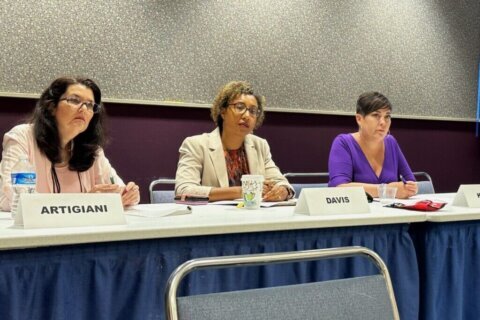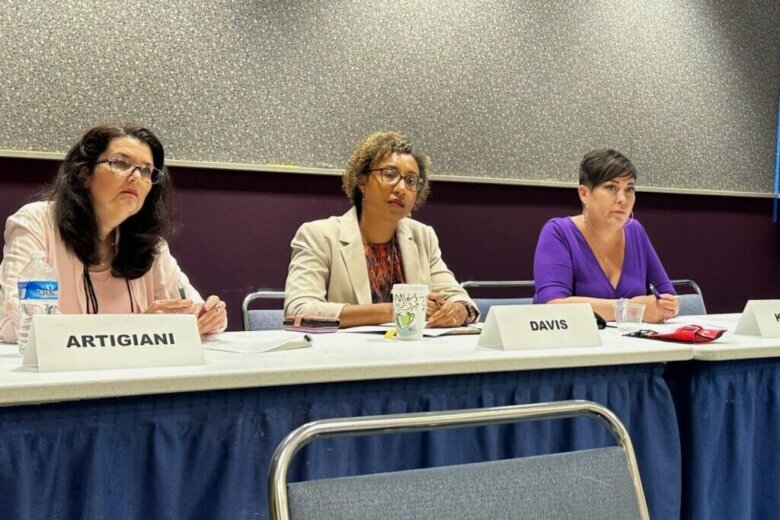This content was republished with permission from WTOP’s news partners at Maryland Matters. Sign up for Maryland Matters’ free email subscription today.
This article was republished with permission from WTOP’s news partners at Maryland Matters. Sign up for Maryland Matters’ free email subscription today.

Maryland state officials, county officers and non-profit organizers gathered in Ocean City on Wednesday to discuss the policy solutions and tactics to face the ever-evolving opioid crisis, as one of many forum discussions that will occur at the annual Maryland Association of Counties summer conference.
State and federal efforts have attempted to reduce substance abuse across the United States, particularly as synthetic opioids like fentanyl contributed to rising fatal overdoses over the past decade.
But part of the challenge of countering opioid use and overdoses is that the battlefield keeps changing, due to new substances gaining use and popularity, said Erin Artigiani, the deputy director for policy at University of Maryland’s Center for Substance Use, Addiction, & Health Research.
“When we were initially doing research, it was very clear what drugs to look for, how to test them and what kinds of effects they would have on people who use them,” Artigiani said, responding to a question about how the opioid crisis compares to the so-called “crack epidemic” of the 80’s and 90’s.
“It was much easier, in a sense, to find out what kind of response and what kind of programs people need,” she continued. “Nowadays, everything changes so quickly, and we’ve gone through so many trends just in the last decade or so, climbing uphill with the synthetic opioids and the variety of different kinds of fentanyl and other substances that are getting cut with other things. Like xylazine for instance. It’s very hard to keep up. And people often don’t realize what they’re taking.”
According to Maryland’s Opioid Dashboard, there were 2,051 fentanyl-involved deaths in 2022, which was 79.4% of total fatal overdoses last year.
“Fentanyl continues to be the primary driver of overdose mortality in Maryland,” the dashboard notes.
According to the Centers for Disease Control and Prevention, a new wave of opioid overdoses started in 2013 and has been increasing since. Opioid-related deaths, particularly those involving illicitly manufactured fentanyl, have especially increased nationally since 2019.
Maryland is working on several fronts to reduce opioid-related overdoses, said Special Secretary of Opioid Response Emily Keller.
“There’s no one-size-fits-all approach to substance abuse treatment,” she said.
One of the focuses of her team includes recovery initiatives that help those struggling with substance abuse to get employment.
“Substance use disorder is a chronic, relapsing disease and comprehensive recovery services help support the health and wellness of individuals following periods of active substance use or treatment,” Keller said at the forum. “Examples of our priorities under this banner are promoting employment in recovery and recovery-ready workplaces.”
Dr. Kisha Davis, the health officer for Montgomery County, highlighted several prevention-focused initiatives intended to help youth and young adults avoid opioids and other substances all together.
“There is a much broader and bigger problem of substance use disorder and also of mental health disorders. And so when we’re thinking about approaches of treating the problem, we have to make sure that we are reaching in on every level and not just focusing in on only those folks who are overdosing.”
“In our primary prevention space, [we are] really thinking about how are we preventing folks from using in the first place, especially focusing on our youth,” she said.
Montgomery County Public Schools has a high school ambassador program called “BTheOne.org” which can help high schoolers identify when their friends may be struggling with substance abuse and discourage others from starting drug use in the first place.
Davis said that they’re looking into expanding the program into middle schools to start preventive education earlier.
“Starting younger makes a bigger difference longer,” she said.
The opioid crisis and discussions on policies to address the issue will continue to be a topic of conversation as the MACo conference continues the rest of the week.








